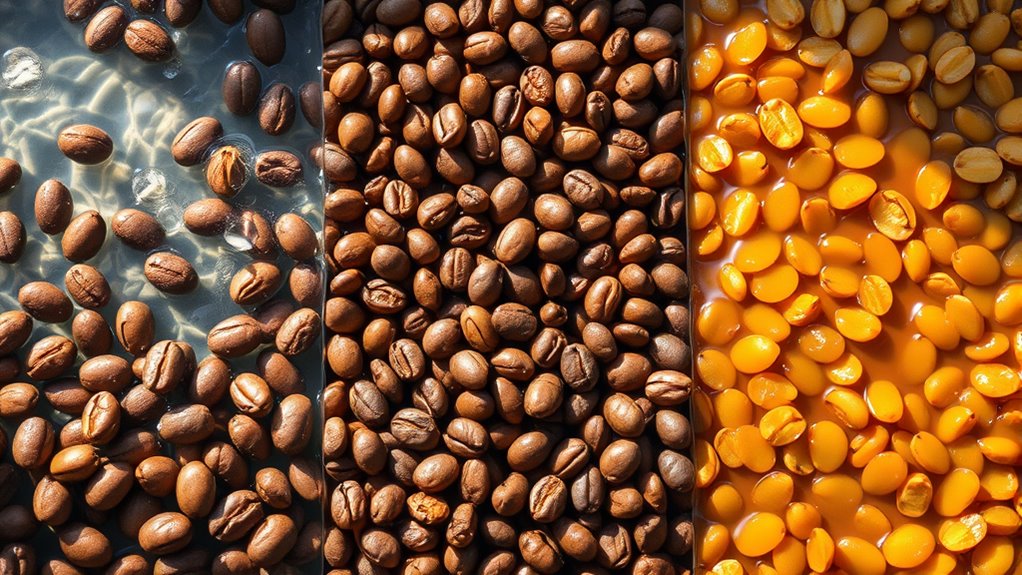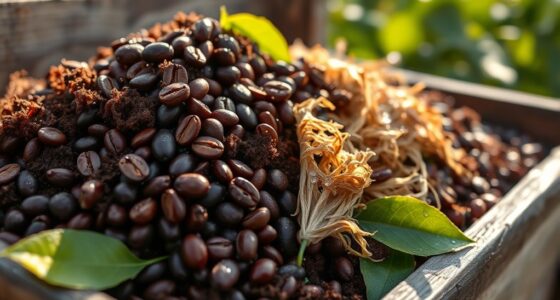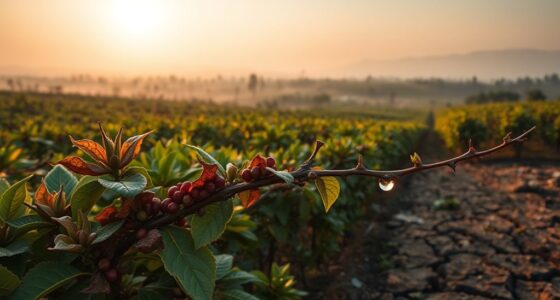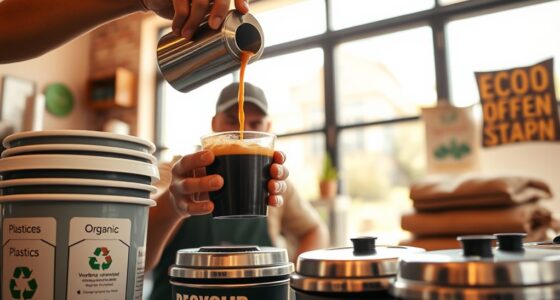In processing methods like washed, natural, and honey, your water use varies considerably. You’ll find that washed processes demand the most water for cleaning impurities, while natural methods use less, focusing on fermentation with minimal water. Honey processing involves mainly cleaning and sterilization to guarantee quality. Managing water efficiently across these methods helps prevent waste, reduces environmental impact, and improves product quality. Keep exploring to discover how smart water practices can optimize your processing operations.
Key Takeaways
- Washed processing involves extensive water use for impurity removal and recycling techniques to minimize waste.
- Natural processing uses less water, relying on minimal intervention like fermentation to preserve quality efficiently.
- Honey processing emphasizes minimal water, mainly for cleaning and sterilization, to optimize extraction and reduce waste.
- Effective water management across all methods ensures sustainability, reduces costs, and maintains product quality.
- Implementing conservation strategies and water quality controls enhances processing efficiency and environmental responsibility.

Water plays a essential role in various industries and daily life, making its use and processing methods critical for sustainability and efficiency. As someone involved in or interested in water management, you understand that conserving water isn’t just about saving the environment—it’s also about maintaining processing efficiency and optimizing resource use. When it comes to processing methods like washed, natural, and honey, how you handle water can greatly impact both quality and sustainability.
Conserving water in processing methods is key to sustainability, efficiency, and quality across industries.
In the washed process, water is used extensively to remove impurities from raw materials, such as coffee beans or other agricultural products. You need to carefully manage water consumption here because excessive use can lead to waste and increased costs. Implementing water conservation techniques, like recycling rinse water or using drip systems, helps maximize processing efficiency. By reducing unnecessary water flow, you guarantee that every drop counts, which not only minimizes environmental impact but also improves the overall effectiveness of the process. Efficient water use in washing also means less wastewater to treat, lowering operational expenses and reducing pollution risks. Additionally, understanding the biological and chemical aspects of water treatment can help optimize water reuse and minimize environmental impact.
The natural processing method relies less on water than washed methods but still involves water in certain stages, such as during fermentation or cleaning. Here, water conservation is equally important because it preserves resources and maintains the sustainability of the process. Since natural processing emphasizes minimal intervention, you want to strike a balance—using just enough water to achieve quality without excess. This method can be more sustainable if managed properly, as it typically consumes less water, yet you must remain vigilant about controlling water flow to prevent wastage and ensure the process remains efficient.
Honey processing takes a different approach, where the focus is on extracting the product without significant water use. However, water may still be involved during cleaning or equipment sterilization. For you, understanding how to optimize water use in these stages can prevent unnecessary waste. Employing water-saving devices and recycling rinse water can enhance overall processing efficiency. This guarantees that even minimal water use is maximized, aligning with sustainability goals and reducing environmental footprint.
In all these methods, the key to success is adopting water conservation strategies that improve processing efficiency. By carefully managing water at every stage—whether washing, natural, or honey processing—you help guarantee the sustainability of your operation. This not only benefits the environment but also enhances your bottom line by reducing costs and waste. Furthermore, integrating water quality management practices can ensure the water used remains safe and appropriate for each stage of processing. Ultimately, mindful water use and smart processing techniques are essential for balancing productivity with sustainability, securing resources for future needs while maintaining high-quality outcomes.
Frequently Asked Questions
How Does Water Use Impact Coffee Flavor Profiles?
Water use directly impacts your coffee flavor profile through water treatment and flavor extraction. When you use clean, properly treated water, it allows for ideal extraction of flavors, highlighting the coffee’s nuanced notes. Excess or poor-quality water can cause over-extraction or muddiness, dulling the taste. So, by controlling water quality and quantity, you guarantee your brewing process produces a rich, balanced coffee that truly reflects the beans’ character.
Are There Environmental Concerns With Different Processing Methods?
You should consider that each processing method has environmental concerns, but eco-friendly practices can reduce impact. For example, washed processing uses significant water, raising water conservation issues, while natural and honey methods typically use less water. By choosing coffee producers committed to eco-friendly practices, you help promote sustainable water use and reduce environmental harm, ensuring that coffee production minimizes resource depletion and supports environmental health.
Can Processing Methods Affect Caffeine Content?
Processing methods can influence caffeine retention in coffee beans. For example, washed methods often remove more of the bean’s outer layers, potentially reducing caffeine slightly, while natural and honey processes may preserve more caffeine due to less extensive washing. So, your choice of processing can affect the caffeine content, as the influence varies depending on how the beans are processed and how much caffeine remains during each method.
What Equipment Is Necessary for Each Processing Technique?
Think of each processing technique as a different musical instrument. For washed coffee, you need water tanks and pulpers; natural processing requires drying beds and open-air patios; honey method involves mucilage removal tools and parchment washers. These processing equipment pieces are essential, as they highlight technique differences. With the right gear, you guarantee each coffee’s unique profile shines through, just like a well-orchestrated symphony.
How Do Processing Methods Influence Shelf Life?
Processing methods directly affect shelf life through fermentation effects and storage techniques. For example, washed coffee may have reduced microbial activity, extending freshness, while natural and honey processes might introduce more fermentation effects, potentially shortening shelf life if stored improperly. You should use proper storage techniques like airtight containers and cool, dark environments to preserve beans longer. Understanding these influences helps you optimize freshness and prevent spoilage.
Conclusion
Understanding different processing methods like washed, natural, and honey helps you appreciate how water use varies. Did you know that natural processing typically uses less water than washed methods? This highlights the importance of choosing sustainable options to conserve water resources. By being aware of these differences, you can make more informed decisions about the coffee you enjoy, helping to support environmentally friendly practices and preserve water for future generations.









